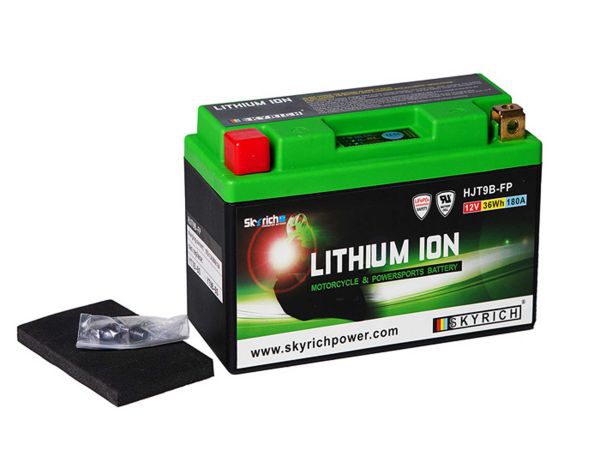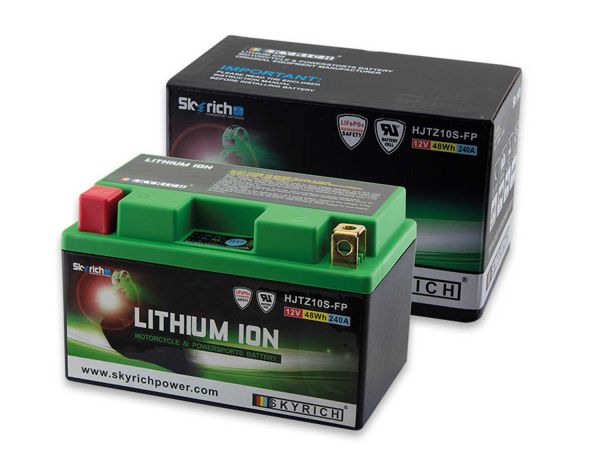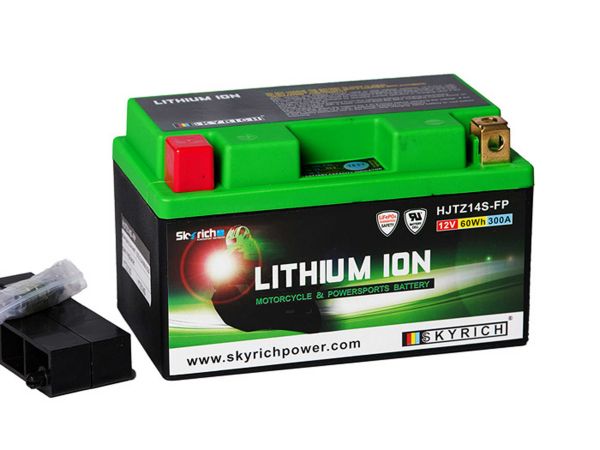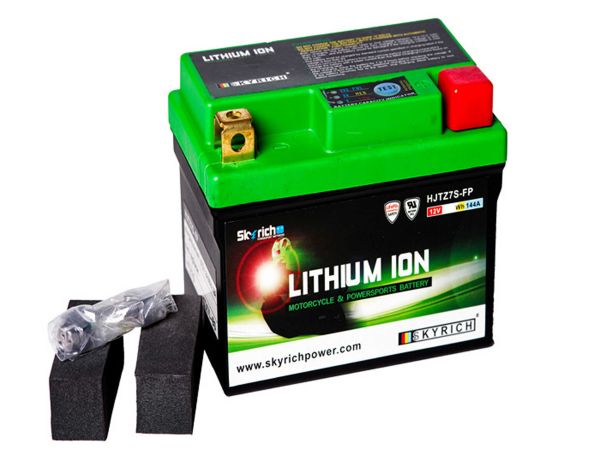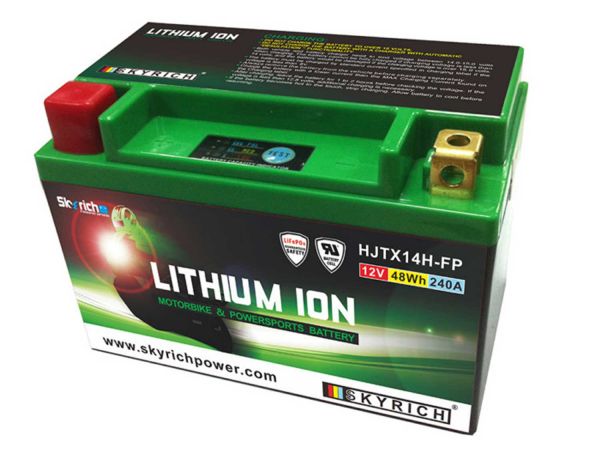Motorcycle batteries - Lithium Ion batteries
Thanks to low-maintenance lithium-ion batteries, the days of lead-acid batteries are now a thing of the past, at least on current motorcycles. When the first power storage batteries with the almost magical-sounding abbreviation "MF" were introduced to the market more than 20 years ago, it represented a major step forward. MF stands for "maintaince-free". In our range in the TecBike Online Shop you will find the lithium ion battery in various versions.
Everything about the motorcycle battery
The temperatures are rising and luring many a biker out of hibernation early. To ensure that the crankshaft turns reliably and the engine thrills with its rich sound, it is not only important to use the bestmotorcycle battery to match the model. For the longest possible service life and maximum reliability, it needs a lot of attention.
As a rule, the compact juice dispenser sits somewhere well hidden under the fairing or the seat. If everything is in order, it works unnoticed. Just as often it is given too little importance in everyday life. It has to function. It does so until the moment when it collapses. Then nothing more works electrically. In order to avoid this moment as much as possible, it is important to pay a little attention to the battery and to observe a few principles. It will thank you with reliability.
Power, power and more power!
In order for the battery to supply enough energy for a problem-free start, even in old weather, it must always be in optimal condition. Machines of the younger generations use a 12 V on-board power supply. Older 50s and 80s and two-wheeled veterans, on the other hand, use a 6 V on-board network. The same rules/recommendations for care and maintenance apply to both variants.
Does maintenance-free really mean maintenance-free?
Sealed and maintenance-free MF batteries have all but supplanted their classic lead-acid cousins with the vent hose attached to the side and the colored plugs on top. But the promise of maintenance-free is deceptive. Every now and then it's necessary to remove the battery, clean it andconnect it to a charger as part of maintenance. Once it's charged, you can put it back in and plug it in. Maintained in this way, it will give you more than just two or three years of faithful service. With good care, batteries can last six or seven years. So the term "maintenance-free" refers primarily to the fact that you don't have to refill it with distilled water.
The capacity
You need the full capacity of your battery, especially for starting. It depends on the type of engine and the cubic capacity. For example, a 1200cc four-cylinder from Japan needs a comparatively small battery (12 V/10 or 12 Ah). The situation is different with a 1200cc two-cylinder boxer from Bavaria or a similarly large V-engine such as from Harley. Here a full 19 ampere hours are required, a large motorcycle battery is needed. Four-cylinder 600 cubic, on the other hand, have verysmall motorcycle batteries witha voltage of 12 volts and 8 to 10 amp-hours. These power donors are often installed at an angle or transversely. For a 125cc, batteries with 6 Ah are usually sufficient.
No matter whether gel battery, lead-acid battery or maintenance-free MF battery, if their voltage falls below 12.3 or 6.3 volts, they must be charged. Signs of this are a "tired" electric starter, as it no longer spins the engine properly. Another indication is a flickering light at low speeds. To measure the state of charge, keep the cables connected tothe battery terminals. Use only suitable measuring instruments for this.
What is the cold test current?
The so-called cold test current refers to the current with which a starter battery can be loaded at -18 °C before the voltage in the battery falls below an equally defined final discharge voltage after a fixed discharge time.
A new motorcycle battery is needed
Before you can install the new power storage unit, it is first necessary to fill it with acid. After that, it still needs to be charged. This applies to both non-maintenance-free and maintenance-free motorcycle batteries. In theory, they are ready for use immediately after the initial filling by means of a dry pre-charge. However, the more carefully you prepare it for its first use, the longer it will live.
This is how it works: remove, charge, install
The disassembly
Important: The ignition must be switched off before removing the battery! Now open the battery compartment (usually under the seat or on a side cover, rarely under the tank). If you are unsure, check the manual. Now unscrew the negative terminal, then the positive terminal. Remove the securing strap and then you can remove the battery completely.
Charging the motorcycle battery
Clean the removed battery under warm running water. You can use a root brush for this. Dry the battery well. Use a brass brush or emery cloth to clean the terminal connections.
After that, charging the motorcycle battery is on your to-do list. First connect the positive terminal, then the negative terminal.Important for lead-acid batteries: Be sure to remove ALL plugs.
Switch on the charger and charge the accumulator with a low charging voltage. Charging currents and charging times are indicated on the motorcycle battery or on the accompanying instruction leaflet. They must not be exceeded. Otherwise there is a risk of damage to the power storage unit.
Correct charging is not for those in a hurry: Only in an emergency should a quick charge be carried out. In principle, slow charging is preferable. After charging, disconnect the motorcycle battery: first the negative terminal, then the positive terminal. Afterwards, the battery should rest for at least 30 minutes. We recommend: Do not insert immediately and start riding.
The installation
Before you reinstall the "full" juice dispenser from your bike, it is important to check the following: Is there a rubber pad for it in the battery box? No? Then, for example, the old rubber floor mat from the car will find a new use. You can cut an acid-proof mat out of it. You can also use a few strips of window sealing rubber, which you can stick under the battery housing. Without this pad, there is a risk of vibration damage.
The battery cable connections must be clean and corrosion-free. If necessary, strip them on both sides with a fine 400-grit emery. You should also note the charging date on the housing. Now insert the accumulator into the battery box.
A little copper paste on the screws ensures good electrical contact and protects against corrosion. Now connect the positive cable first, followed by the negative cable. Make sure that the cables do not bend excessively or rub anywhere. Now the protective caps on the connections are missing and finally you close the lid of the box.
Convert to a gel battery?
In the so-called gel battery, the acid is stored in the form of viscous jelly inside the battery. In principle, this battery variant can be used instead of the MF battery on very modern machines. If an older motorcycle is equipped with a lead-acid battery as standard, however, extreme caution is advised. The charging curve of the alternator regulator is not flat enough: the gel battery is repeatedly hit with too heavy a shot of charging current. In addition, you need special chargers suitable for modern batteries.
Everything about motorcycle batteries from your TecBike Shop
To ensure that your bike is always ready to go, you will not only find the best motorcycle battery such as the AGM battery for your bike in our range at TecBike. Our range also includes everything you need for maintenance and care. Do you have any questions about our products? We will be happy to advise you without obligation and help you make the right choice.
Close window Motorcycle batteries - Lithium Ion batteries
Thanks to low-maintenance lithium-ion batteries, the days of lead-acid batteries are now a thing of the past, at least on current motorcycles. When the first power storage batteries with the almost magical-sounding abbreviation "MF" were introduced to the market more than 20 years ago, it represented a major step forward. MF stands for "maintaince-free". In our range in the TecBike Online Shop you will find the lithium ion battery in various versions.
Everything about the motorcycle battery
The temperatures are rising and luring many a biker out of hibernation early. To ensure that the crankshaft turns reliably and the engine thrills with its rich sound, it is not only important to use the bestmotorcycle battery to match the model. For the longest possible service life and maximum reliability, it needs a lot of attention.
As a rule, the compact juice dispenser sits somewhere well hidden under the fairing or the seat. If everything is in order, it works unnoticed. Just as often it is given too little importance in everyday life. It has to function. It does so until the moment when it collapses. Then nothing more works electrically. In order to avoid this moment as much as possible, it is important to pay a little attention to the battery and to observe a few principles. It will thank you with reliability.
Power, power and more power!
In order for the battery to supply enough energy for a problem-free start, even in old weather, it must always be in optimal condition. Machines of the younger generations use a 12 V on-board power supply. Older 50s and 80s and two-wheeled veterans, on the other hand, use a 6 V on-board network. The same rules/recommendations for care and maintenance apply to both variants.
Does maintenance-free really mean maintenance-free?
Sealed and maintenance-free MF batteries have all but supplanted their classic lead-acid cousins with the vent hose attached to the side and the colored plugs on top. But the promise of maintenance-free is deceptive. Every now and then it's necessary to remove the battery, clean it andconnect it to a charger as part of maintenance. Once it's charged, you can put it back in and plug it in. Maintained in this way, it will give you more than just two or three years of faithful service. With good care, batteries can last six or seven years. So the term "maintenance-free" refers primarily to the fact that you don't have to refill it with distilled water.
The capacity
You need the full capacity of your battery, especially for starting. It depends on the type of engine and the cubic capacity. For example, a 1200cc four-cylinder from Japan needs a comparatively small battery (12 V/10 or 12 Ah). The situation is different with a 1200cc two-cylinder boxer from Bavaria or a similarly large V-engine such as from Harley. Here a full 19 ampere hours are required, a large motorcycle battery is needed. Four-cylinder 600 cubic, on the other hand, have verysmall motorcycle batteries witha voltage of 12 volts and 8 to 10 amp-hours. These power donors are often installed at an angle or transversely. For a 125cc, batteries with 6 Ah are usually sufficient.
No matter whether gel battery, lead-acid battery or maintenance-free MF battery, if their voltage falls below 12.3 or 6.3 volts, they must be charged. Signs of this are a "tired" electric starter, as it no longer spins the engine properly. Another indication is a flickering light at low speeds. To measure the state of charge, keep the cables connected tothe battery terminals. Use only suitable measuring instruments for this.
What is the cold test current?
The so-called cold test current refers to the current with which a starter battery can be loaded at -18 °C before the voltage in the battery falls below an equally defined final discharge voltage after a fixed discharge time.
A new motorcycle battery is needed
Before you can install the new power storage unit, it is first necessary to fill it with acid. After that, it still needs to be charged. This applies to both non-maintenance-free and maintenance-free motorcycle batteries. In theory, they are ready for use immediately after the initial filling by means of a dry pre-charge. However, the more carefully you prepare it for its first use, the longer it will live.
This is how it works: remove, charge, install
The disassembly
Important: The ignition must be switched off before removing the battery! Now open the battery compartment (usually under the seat or on a side cover, rarely under the tank). If you are unsure, check the manual. Now unscrew the negative terminal, then the positive terminal. Remove the securing strap and then you can remove the battery completely.
Charging the motorcycle battery
Clean the removed battery under warm running water. You can use a root brush for this. Dry the battery well. Use a brass brush or emery cloth to clean the terminal connections.
After that, charging the motorcycle battery is on your to-do list. First connect the positive terminal, then the negative terminal.Important for lead-acid batteries: Be sure to remove ALL plugs.
Switch on the charger and charge the accumulator with a low charging voltage. Charging currents and charging times are indicated on the motorcycle battery or on the accompanying instruction leaflet. They must not be exceeded. Otherwise there is a risk of damage to the power storage unit.
Correct charging is not for those in a hurry: Only in an emergency should a quick charge be carried out. In principle, slow charging is preferable. After charging, disconnect the motorcycle battery: first the negative terminal, then the positive terminal. Afterwards, the battery should rest for at least 30 minutes. We recommend: Do not insert immediately and start riding.
The installation
Before you reinstall the "full" juice dispenser from your bike, it is important to check the following: Is there a rubber pad for it in the battery box? No? Then, for example, the old rubber floor mat from the car will find a new use. You can cut an acid-proof mat out of it. You can also use a few strips of window sealing rubber, which you can stick under the battery housing. Without this pad, there is a risk of vibration damage.
The battery cable connections must be clean and corrosion-free. If necessary, strip them on both sides with a fine 400-grit emery. You should also note the charging date on the housing. Now insert the accumulator into the battery box.
A little copper paste on the screws ensures good electrical contact and protects against corrosion. Now connect the positive cable first, followed by the negative cable. Make sure that the cables do not bend excessively or rub anywhere. Now the protective caps on the connections are missing and finally you close the lid of the box.
Convert to a gel battery?
In the so-called gel battery, the acid is stored in the form of viscous jelly inside the battery. In principle, this battery variant can be used instead of the MF battery on very modern machines. If an older motorcycle is equipped with a lead-acid battery as standard, however, extreme caution is advised. The charging curve of the alternator regulator is not flat enough: the gel battery is repeatedly hit with too heavy a shot of charging current. In addition, you need special chargers suitable for modern batteries.
Everything about motorcycle batteries from your TecBike Shop
To ensure that your bike is always ready to go, you will not only find the best motorcycle battery such as the AGM battery for your bike in our range at TecBike. Our range also includes everything you need for maintenance and care. Do you have any questions about our products? We will be happy to advise you without obligation and help you make the right choice.

